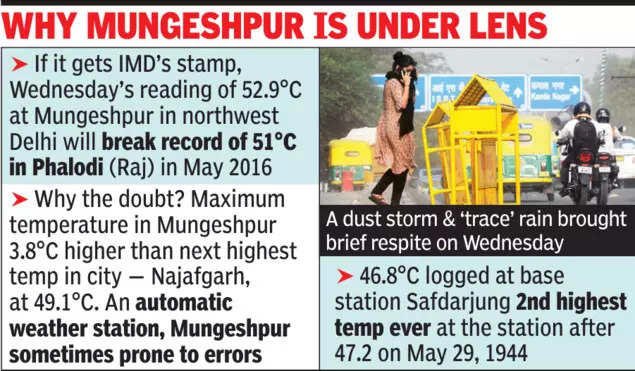Mungeshpur, a locality in the sprawling urban expanse of Delhi, recorded an unprecedented temperature of 52.9°C. This extreme temperature has not only shattered previous records but also thrust Mungeshpur into the spotlight as an alarming indicator of the growing climate crisis.
The implications of such extreme temperatures are profound and multifaceted, affecting health, infrastructure, and the environment. The residents of Mungeshpur, like many in Delhi, are no strangers to the intense summer heat, but this level of temperature brings a new and perilous dimension to their daily lives. Heatwaves in Delhi are typically marked by temperatures soaring into the mid-40s, but 52.9°C is a critical threshold that poses immediate dangers to human health. Heatstroke, dehydration, and other heat-related illnesses can become rampant, overwhelming healthcare facilities already stretched thin.
One of the most immediate effects of such extreme heat is the strain on the human body. Prolonged exposure to temperatures above 50°C can lead to severe dehydration and heatstroke, conditions that can be fatal if not treated promptly. Vulnerable populations, including the elderly, children, and those with preexisting health conditions, are at heightened risk. The heat can also exacerbate chronic illnesses, such as respiratory and cardiovascular diseases, increasing morbidity and mortality rates. Hospitals and clinics in and around Mungeshpur have reported a spike in heat-related ailments, underscoring the urgent need for robust public health interventions.
Infrastructure in Mungeshpur, like much of Delhi, is not built to withstand such extreme temperatures. The heat can cause roads to buckle and power grids to fail, leading to blackouts and further compounding the distress of residents. The increased demand for electricity, primarily due to air conditioning and cooling systems, puts immense pressure on the power supply, often resulting in prolonged outages. Water scarcity is another critical issue, as the extreme heat accelerates the evaporation of surface water sources and increases the demand for drinking water. This situation forces residents to rely on dwindling groundwater reserves, further depleting this vital resource.
The environmental impact of such extreme temperatures is equally concerning. Urban heat islands, areas that experience higher temperatures due to human activities, are exacerbated by the lack of green spaces and high levels of pollution in Delhi. The sweltering heat accelerates the formation of ground-level ozone, a harmful air pollutant that can aggravate respiratory problems. Additionally, prolonged periods of extreme heat can lead to the loss of biodiversity, as both flora and fauna struggle to survive in such harsh conditions. The high temperature also threatens agriculture in the surrounding areas, as crops wilt and soil moisture levels plummet, jeopardizing food security for the local population.
The 52.9°C record has sparked a conversation about the broader implications of climate change and the urgent need for adaptive strategies. Delhi, like many major cities around the world, faces the dual challenge of mitigating climate change while adapting to its inevitable impacts. Urban planning and infrastructure development need to prioritize sustainability and resilience to extreme weather events. This includes increasing green cover, improving water management systems, and investing in renewable energy sources to reduce the urban heat island effect and enhance the city’s capacity to cope with heatwaves.
Public awareness and preparedness are also crucial components of addressing the risks associated with extreme heat. Educating residents about heat-related health risks and safety measures can help mitigate the impact on vulnerable populations. Community cooling centers, where people can seek refuge from the heat, and the distribution of drinking water are essential measures to protect public health during heatwaves.
Mungeshpur’s extreme temperature is a stark reminder of the urgent need to address climate change at both local and global levels. It highlights the vulnerability of urban areas to the escalating impacts of global warming and the pressing need for comprehensive strategies to protect human health, infrastructure, and the environment. As cities like Delhi grapple with the realities of climate change, proactive measures and collaborative efforts will be essential to safeguard the well-being of their residents and build resilient, sustainable communities for the future.

